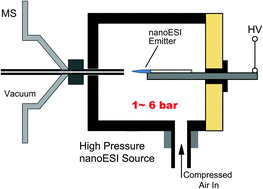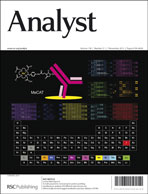High pressure nanoelectrospray ionization mass spectrometry for analysis of aqueous solutions†
Abstract
Nanoelectrospray ionization (nanoESI) with a very fine emitter and nanoliter solution flow rate is known to be suitable for aqueous solutions. However, under atmospheric pressure, its stability with aqueous solutions is not always guaranteed particularly in the negative ion mode where corona and arc discharge tend to occur more easily. Electrical discharge can be quenched to a certain extent by adding electron scavenging gases like SF6 or CO2 to the ion source. The onset potential that is required to induce the discharge also increases with an increase of gas pressure. Recently, we have reported on a series of high pressure electrospray ion sources that were stable in both positive and negative ion modes using air or N2 as the working gas. In this paper, we compare the performance of nanoelectrospray under atmospheric pressure and super-atmospheric pressure for the analysis of samples in aqueous solution. The comparative study was performed using the same ion source chamber that could be pressurized up to 6 bar. The pressure in the first pumping stage of the mass spectrometer was kept constant when the ion source pressure was changed by using an additional pump with variable pumping speed. High pressure nanoESI optimized at 2–3 bar demonstrated a 3–5 times improvement in ion signal intensity compared to atmospheric pressure nanoESI, and the signal stability was significantly improved particularly in the negative mode.


 Please wait while we load your content...
Please wait while we load your content...